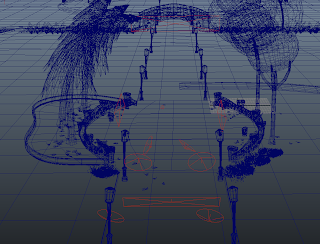Unfortunately I was sick for an entire week and have been
set back with workload. Due to this, I also have missed out in getting feedback
that I may have needed earlier.
This week I splayed specifically for adding creative lights.
The last few weeks I had been building up a knowledge about getting more
control in Maya whilst also keeping with the quality/appearance of a day lit
scene.
METHOD
Aim
The main thing I wanted to concentrate on was to develop a
lighting system that was readable and enhance the scene. Naturally I wanted the
center court to be working as the focal point as that was the designated stage
for action. I also wanted there to be a sense of depth in the shot, so the
viewer wouldn’t feel closed in when viewing.
Fig.1, Base image lit
Setup
In order to establish a base lit scene to work with I used
the previous lit scene and added to it. As a further update for the actual
environment I chose to have more assets in there to give a more motivation for
creative light.
Fig.2, Older light rig
Creative lights added:
- - Area lights to light up characters faces
- - Target light to brighten up the center of the
court
- - Coloured lights for the subjects backdrop
(stylistic)
- - Golden ambient light to warm up the shot
- - Another area light for asset
Fig.3, Light setup from afar
Fig.4, Light setup close
As an addition to creative lighting I also began to remove various
lights to supplement for the expense in render time. All the bounced lights
were removed and replaced with Final Gather as it was easier to manage and less
time to render.
Lights removed or changed:
- - Hot distant area lights removed
- - All bounced lights (lighting stalls, walls and
lamps)
- - Distant light increased greatly to light up hill
in the distance
- - Sky area light replaced with ambient light and
light linked solely to it
- - Directional light intensity reduced
[image]
RESULTS
Fig.5, Final result
For what I had created I took reference from the
environmental lighting in ‘One Man Band’ as it had a similar hierarchy in accordance
to what I had.
Fig.6, One Man Band (Andrews & Jimenez, 2005)
AFTERMATH
Light Linking
Another issue I discovered unexpectedly was the practicality
of link linking in a 3D animation. As far as setting it up in a scene it is an
effective and necessary tool that gives more control over what receives light. When
the light rig is exported and referenced into a different scene it seems to
lose the retained information and reset all of the specific light connections. The
reason to this seems obvious though. If you are importing a rig the information
would be retained ideally in connection with the name of the asset and possibly
the kind of object itself. When the lights enter a new shot they do not
recognise the objects they are meant to connect with and therefore do nothing
(aka reset).
I haven’t exactly solved this problem but have promising
strategies in dealing with it.
This include:
-
Mel scripting
-
Asset manager
-
Easy Light Link
This wasn’t so much something that I didn’t necessarily need
to figure out, but came out of my research.
Final weeks
Recently I actually did get feedback (despite the major
delay) after finally showing the results of my progress. What entailed was a critical
kick back into reality of what was needed to be achieved. My thesis was not so
much aesthetic based but rather efficiency based relative with the best quality
possible. I haven’t really been focusing on the actual timing of my renders
which was the point of it all.
My new goal is now clearer. Focusing on trying to get an
equally appealing lighting system that is more efficient than using Physical
sun and sky. This won’t necessarily mean that I’ll be diverting from other
renderers but story telling light has to be axed.
Learning Contract
Updating from new goal
Week 10 – Working out possible ways to lower render times
whilst keeping good quality in Maya. I also may show the advantages to having
more control over scene lighting rather than Physical sun and sky pre-sets.
Week 11 – Looking at the effect of different renderers
within Maya and how they may speed up render time.
References
Andrews, M.(Director), & Jimenez, A.(Director).(2005).One Man Band [Motion picture].CA, Pixar.





















